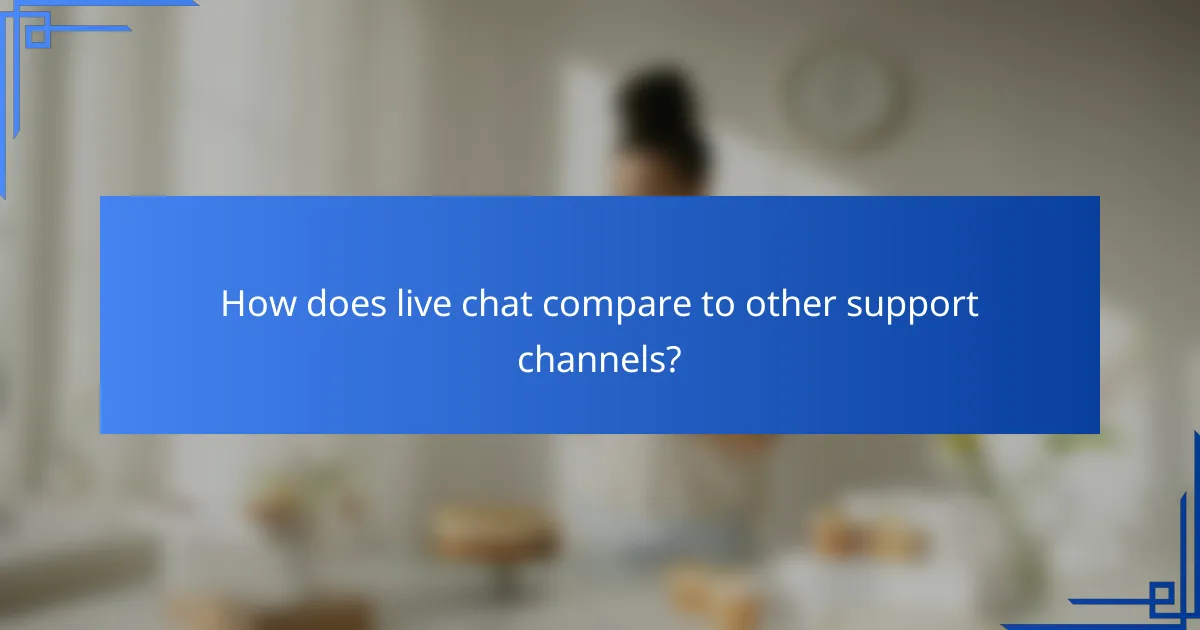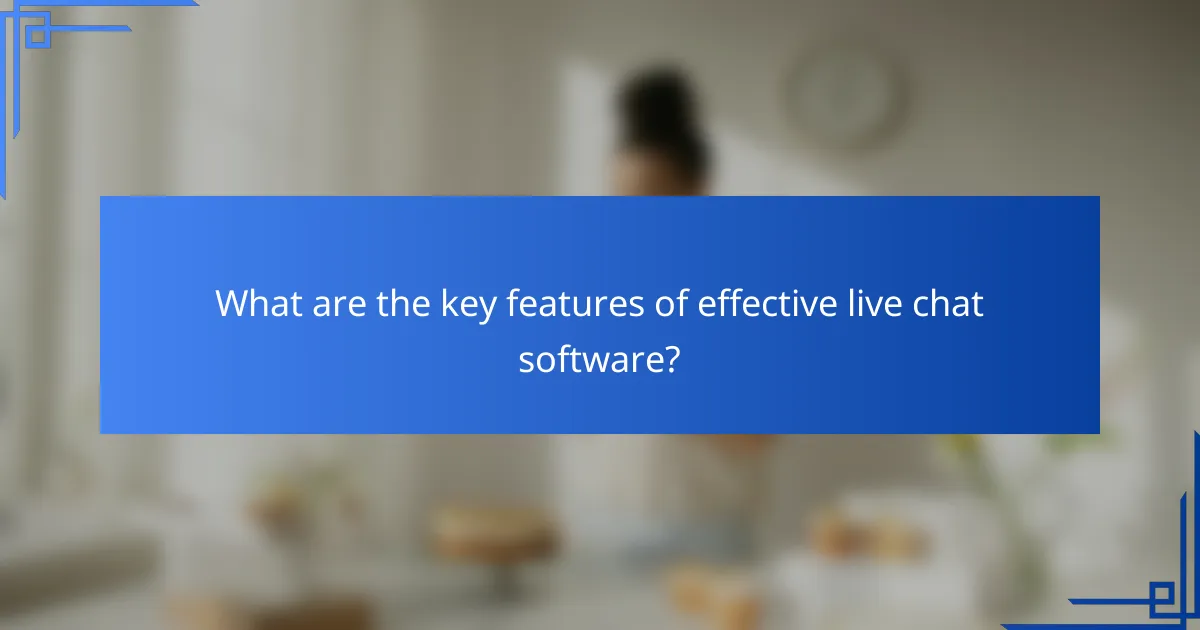Live chat has become a vital tool for enhancing customer satisfaction and engagement by facilitating quick and efficient communication. This real-time interaction not only allows businesses to provide immediate assistance but also fosters a more interactive experience, leading to increased customer loyalty. By offering a unique blend of immediacy and convenience, live chat stands out among traditional support channels, ensuring that inquiries are resolved swiftly and effectively.

How does live chat improve customer satisfaction?
Live chat enhances customer satisfaction by providing quick and efficient communication between businesses and their customers. This real-time interaction allows for immediate assistance, leading to a more positive experience and increased loyalty.
Immediate response times
One of the most significant advantages of live chat is its ability to deliver immediate response times. Customers can receive answers to their inquiries within seconds, often eliminating the frustration associated with waiting on hold or for email replies. This quick access to information can significantly boost customer satisfaction.
For instance, many businesses aim to respond to live chat inquiries within a few seconds, which is much faster than traditional customer service channels. This rapid engagement helps in retaining customers who might otherwise abandon their queries due to delays.
Personalized customer interactions
Live chat allows for personalized interactions that can enhance the customer experience. Agents can address customers by name and tailor responses based on previous interactions or specific needs, creating a more engaging and relevant conversation.
Using customer data, businesses can provide recommendations or solutions that are directly aligned with the customer’s history and preferences, making them feel valued and understood.
24/7 availability
Offering live chat support around the clock ensures that customers can get assistance whenever they need it, regardless of time zones. This 24/7 availability caters to a global audience, accommodating customers who may not be able to reach out during standard business hours.
By providing constant access to support, businesses can capture inquiries and resolve issues that might otherwise go unattended, leading to higher overall satisfaction levels.
Reduced customer effort
Live chat reduces the effort required from customers to get help. Instead of navigating through complex phone menus or waiting for email responses, customers can simply click a button to initiate a chat. This streamlined process makes it easier for customers to find solutions quickly.
Additionally, live chat often includes features like file sharing and quick links to FAQs, further minimizing the steps customers need to take to resolve their issues.
Enhanced problem resolution
Live chat can lead to enhanced problem resolution by allowing agents to address multiple inquiries simultaneously and access resources quickly. This capability means that customers can receive comprehensive solutions in a single interaction, rather than having to follow up multiple times.
Moreover, the ability to escalate issues to specialized teams within the chat platform can ensure that complex problems are resolved efficiently, improving customer trust and satisfaction in the service provided.

What are the benefits of live chat for engagement?
Live chat enhances customer engagement by providing instant communication, which fosters a more interactive and satisfying experience. Customers appreciate the immediacy of responses, leading to increased satisfaction and loyalty.
Increased user retention
Live chat can significantly boost user retention by addressing customer inquiries in real-time. When customers receive prompt assistance, they are more likely to return, as their needs are met quickly and efficiently.
For example, businesses that implement live chat often see retention rates improve by a notable margin, as users feel valued and supported throughout their journey.
Higher conversion rates
Implementing live chat can lead to higher conversion rates by guiding potential customers through the purchasing process. When users have immediate access to support, they are more likely to complete transactions rather than abandon their carts.
Studies suggest that businesses with live chat features can experience conversion rate increases ranging from 20% to 30%, as customers receive the reassurance they need to finalize their purchases.
Real-time feedback collection
Live chat allows businesses to gather real-time feedback from customers, providing insights into their experiences and preferences. This immediate feedback can help identify areas for improvement and enhance overall service quality.
Companies can use chat transcripts to analyze common questions or concerns, allowing them to make data-driven adjustments to their offerings and customer service strategies.
Proactive customer support
With live chat, businesses can offer proactive customer support by initiating conversations with users based on their behavior on the website. For instance, if a user lingers on a product page, a chat invitation can prompt them to ask questions or receive assistance.
This proactive approach not only enhances the customer experience but can also lead to increased sales, as customers feel supported and engaged throughout their decision-making process.

How does live chat compare to other support channels?
Live chat offers a unique blend of immediacy and convenience that sets it apart from other support channels like email and phone. It enables real-time communication, which can significantly enhance customer satisfaction and engagement by providing quick resolutions to inquiries.
Faster than email support
Live chat typically resolves customer issues in a matter of minutes, whereas email support can take hours or even days for a response. Customers appreciate the instant feedback that live chat provides, which helps them feel valued and understood.
For example, while an email response might take 24 hours, a live chat interaction can conclude within 5 to 10 minutes. This speed can lead to higher customer satisfaction rates and a more positive perception of the brand.
More efficient than phone support
Live chat is often more efficient than phone support because it allows agents to handle multiple conversations simultaneously. This multitasking capability means that customers can receive assistance without long wait times typically associated with phone calls.
In practice, a customer may spend several minutes on hold when calling support, while live chat can provide immediate answers. This efficiency can lead to reduced operational costs and improved service levels for businesses.
Integration with social media
Live chat can seamlessly integrate with social media platforms, allowing businesses to engage with customers where they already spend their time. This integration enhances accessibility and can lead to increased customer interaction and satisfaction.
For instance, a customer can initiate a live chat directly from a brand’s Facebook page, making it easy to get support without switching platforms. This capability not only streamlines the customer experience but also helps brands maintain a consistent presence across multiple channels.

What are the key features of effective live chat software?
Effective live chat software should enhance customer satisfaction and engagement by providing timely support and seamless communication. Key features include AI-powered chatbots, analytics tools, multi-channel integration, and customizable chat widgets, all of which contribute to a more efficient customer service experience.
AI-powered chatbots
AI-powered chatbots can handle a variety of customer inquiries automatically, improving response times and availability. These bots can provide 24/7 support, answer frequently asked questions, and escalate complex issues to human agents when necessary.
When implementing chatbots, ensure they are trained on relevant data to understand customer queries effectively. Regular updates and monitoring are essential to maintain their performance and relevance.
Analytics and reporting tools
Analytics and reporting tools allow businesses to track chat performance metrics, such as response times, customer satisfaction scores, and chat volume. This data helps identify trends and areas for improvement in customer service.
Utilizing these tools can inform staffing decisions and training needs, ensuring that your team is equipped to meet customer demands. Regularly reviewing analytics can lead to actionable insights that enhance overall service quality.
Multi-channel integration
Multi-channel integration enables live chat software to connect with various communication platforms, such as social media, email, and SMS. This feature ensures that customers can reach out through their preferred channels, creating a more cohesive experience.
When choosing a live chat solution, look for one that seamlessly integrates with your existing systems. This will streamline operations and provide a unified view of customer interactions across different platforms.
Customizable chat widgets
Customizable chat widgets allow businesses to tailor the appearance and functionality of their chat interface to align with their brand. This personalization can enhance user experience and encourage more customers to engage with support.
Consider options for adjusting colors, fonts, and placement on your website. A well-designed chat widget can significantly impact customer engagement and satisfaction, making it essential to test different designs for effectiveness.

What factors influence the success of live chat?
The success of live chat is influenced by several key factors, including agent training, response time, and user interface design. These elements directly impact customer satisfaction and engagement levels, making them crucial for effective live chat implementation.
Agent training and expertise
Well-trained agents are essential for successful live chat interactions. They should possess strong communication skills, product knowledge, and the ability to resolve issues efficiently. Regular training sessions can help agents stay updated on company policies and best practices.
Consider implementing role-playing scenarios during training to simulate real customer interactions. This approach helps agents develop problem-solving skills and learn to handle various customer personalities effectively.
Response time optimization
Quick response times are vital for maintaining customer engagement in live chat. Aim for initial responses within a few seconds, as delays can lead to frustration and abandonment. Tools like automated greetings can help manage customer expectations while they wait for a representative.
Monitor response times regularly and set benchmarks for your team. Aiming for a target of under two minutes for full resolution can significantly enhance customer satisfaction.
User interface design
The design of the live chat interface plays a crucial role in user experience. A clean, intuitive layout allows customers to navigate easily and find help without confusion. Ensure that the chat window is easily accessible and visually appealing.
Incorporate features like quick response buttons and FAQs to streamline interactions. Testing different designs with real users can provide valuable feedback on what works best for your audience.
